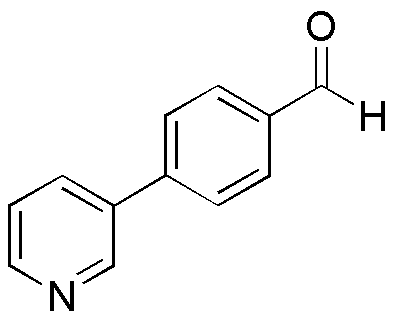4-(Pyridin-3-yl)benzaldehyde is widely utilized in research focused on:
- Synthesis of Pharmaceuticals: This compound serves as an important intermediate in the synthesis of various pharmaceutical agents, particularly those targeting neurological disorders, enhancing drug development processes.
- Organic Synthesis: It is commonly used in organic chemistry for the construction of complex molecules, allowing researchers to create diverse chemical libraries for screening in drug discovery.
- Fluorescent Probes: The compound can be modified to develop fluorescent probes for biological imaging, providing researchers with tools to visualize cellular processes in real-time.
- Material Science: It is applied in the development of advanced materials, such as organic light-emitting diodes (OLEDs), contributing to innovations in display technologies.
- Coordination Chemistry: This compound acts as a ligand in coordination chemistry, facilitating the study of metal complexes that have applications in catalysis and materials science.
General Information
Properties
Safety and Regulations
Applications
4-(Pyridin-3-yl)benzaldehyde is widely utilized in research focused on:
- Synthesis of Pharmaceuticals: This compound serves as an important intermediate in the synthesis of various pharmaceutical agents, particularly those targeting neurological disorders, enhancing drug development processes.
- Organic Synthesis: It is commonly used in organic chemistry for the construction of complex molecules, allowing researchers to create diverse chemical libraries for screening in drug discovery.
- Fluorescent Probes: The compound can be modified to develop fluorescent probes for biological imaging, providing researchers with tools to visualize cellular processes in real-time.
- Material Science: It is applied in the development of advanced materials, such as organic light-emitting diodes (OLEDs), contributing to innovations in display technologies.
- Coordination Chemistry: This compound acts as a ligand in coordination chemistry, facilitating the study of metal complexes that have applications in catalysis and materials science.
Documents
Safety Data Sheets (SDS)
The SDS provides comprehensive safety information on handling, storage, and disposal of the product.
Product Specification (PS)
The PS provides a comprehensive breakdown of the product’s properties, including chemical composition, physical state, purity, and storage requirements. It also details acceptable quality ranges and the product's intended applications.
Certificates of Analysis (COA)
Search for Certificates of Analysis (COA) by entering the products Lot Number. Lot and Batch Numbers can be found on a product’s label following the words ‘Lot’ or ‘Batch’.
Número de catálogo
Número de lote/lote
Certificates Of Origin (COO)
This COO confirms the country where the product was manufactured, and also details the materials and components used in it and whether it is derived from natural, synthetic, or other specific sources. This certificate may be required for customs, trade, and regulatory compliance.
Número de catálogo
Número de lote/lote
Safety Data Sheets (SDS)
The SDS provides comprehensive safety information on handling, storage, and disposal of the product.
DownloadProduct Specification (PS)
The PS provides a comprehensive breakdown of the product’s properties, including chemical composition, physical state, purity, and storage requirements. It also details acceptable quality ranges and the product's intended applications.
DownloadCertificates of Analysis (COA)
Search for Certificates of Analysis (COA) by entering the products Lot Number. Lot and Batch Numbers can be found on a product’s label following the words ‘Lot’ or ‘Batch’.
Número de catálogo
Número de lote/lote
Certificates Of Origin (COO)
This COO confirms the country where the product was manufactured, and also details the materials and components used in it and whether it is derived from natural, synthetic, or other specific sources. This certificate may be required for customs, trade, and regulatory compliance.


